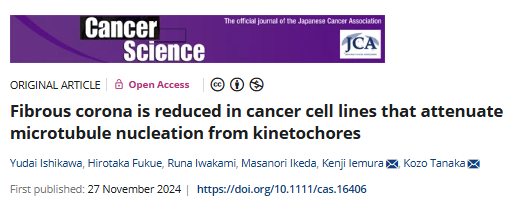A study published in Cancer Science titled Fibrous corona is reduced in cancer cell lines that attenuate microtubule nucleation from kinetochores revealed that breast cancer cell lines show a reduced kinetochore localization of ROD, ZW10, and Zwilch, components of the fibrous corona, compared with non‐transformed breast epithelial cell lines. The fibrous corona is a structure formed on kinetochores before their end‐on attachment to microtubules and plays a role in efficient kinetochore capture and the spindle assembly checkpoint.

Notably, the reduction in the fibrous corona was not due to reduced expression levels of the fibrous corona components or to a reduction in outer kinetochore components. Kinetochore localization of Bub1 and CENP‐E, which play a role in the recruitment of the fibrous corona to kinetochores, was reduced in cancer cell lines, presumably due to reduced activity of Mps1, which is required for their recruitment to kinetochores through phosphorylating KNL1. Increasing kinetochore localization of Bub1 and CENP‐E in cancer cells restored the level of the fibrous corona. Cancer cell lines showed a reduced capacity to nucleate microtubules from kinetochores, which was recently shown to be dependent on the fibrous corona, and increasing kinetochore localization of Bub1 and CENP‐E restored the microtubule nucleation capacity on kinetochores. The study revealed a distinct feature of cancer cell lines that may be related to CIN.
Antibody Application
The Anti-phospho-CASC5 (pT943, phospho-MELT-Knl1) (Catalog: RHK27001) provided by AntibodySystem specifically detects phosphorylation of the MELT motif (Met-Glu-Leu-Thr) at threonine 943 (T943) on KNL1, enabling assessment of Mps1 kinase activity in regulating KNL1 phosphorylation.
The Anti-phospho-CASC5 (pT943, phospho-MELT-Knl1) (Catalog: RHK27001) revealed that reduced Mps1 kinase activity underlies fibrous corona dysfunction in cancer cells, providing critical evidence for understanding CIN origins. The Mps1-KNL1-Bub1/CENP-E axis emerges as a potential therapeutic target for cancers with CIN.

FIGURE 3. Overexpression of Bub1 or CENP‐E restores the level of kinetochore localization of the fibrous corona in cancer cells.
This study uncovers a novel mechanism of fibrous corona dysfunction in cancer cells, emphasizing the pivotal role of the Bub1/CENP-E-Mps1 axis in regulating microtubule nucleation and chromosomal stability. These discoveries deepen our understanding of CIN mechanisms and provide a theoretical foundation for developing therapeutic strategies targeting fibrous corona-associated pathways or kinases.
Article: https://onlinelibrary.wiley.com/doi/10.1111/cas.16406
AntibodySystem engineering platform allows us to offer these antibodies in various isotype and species formats, including rabbit, human, and mouse. If you have any inquiries or need further information, please feel free to reach out to us.
Get in touch:support@antibodysystem.com
